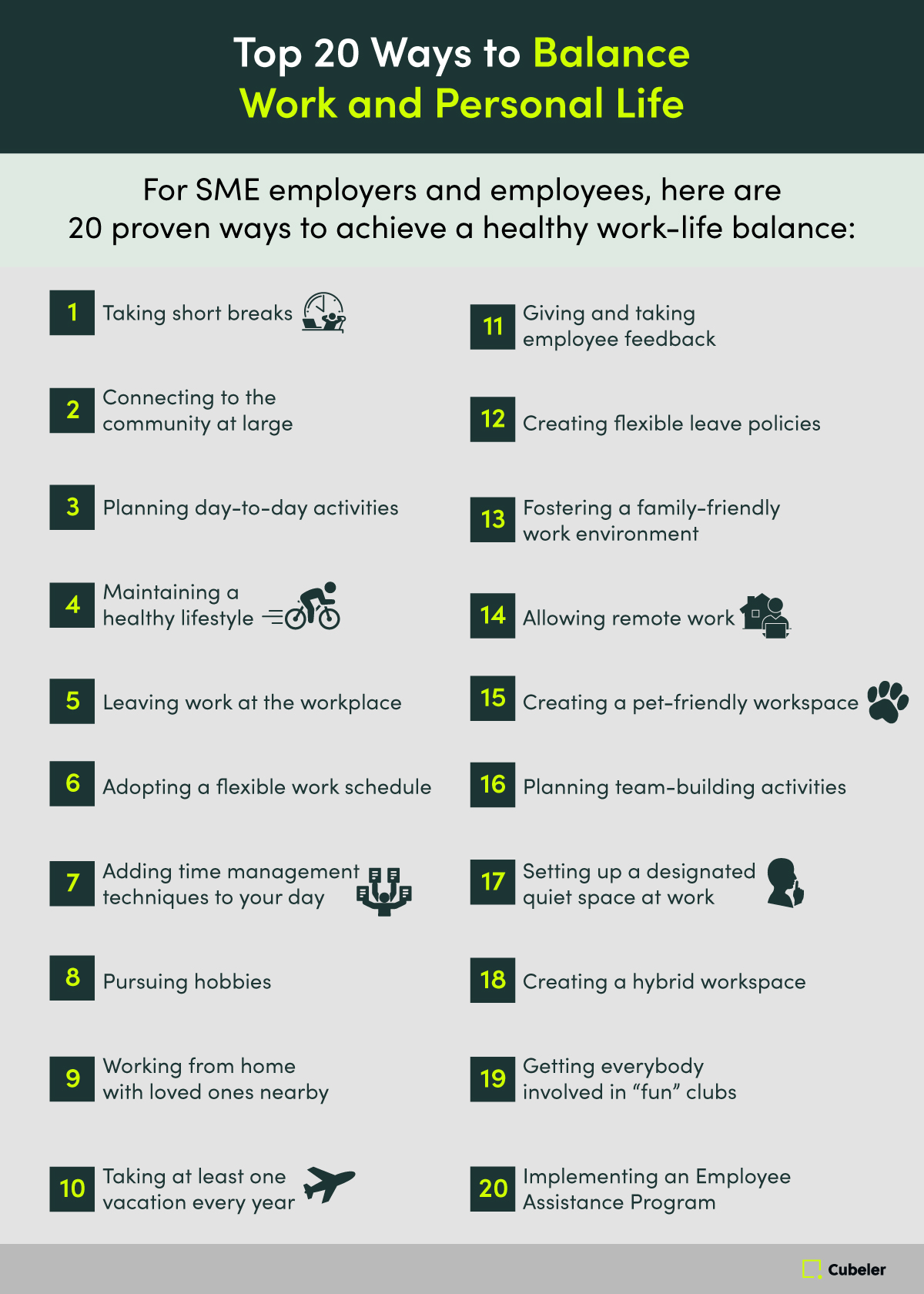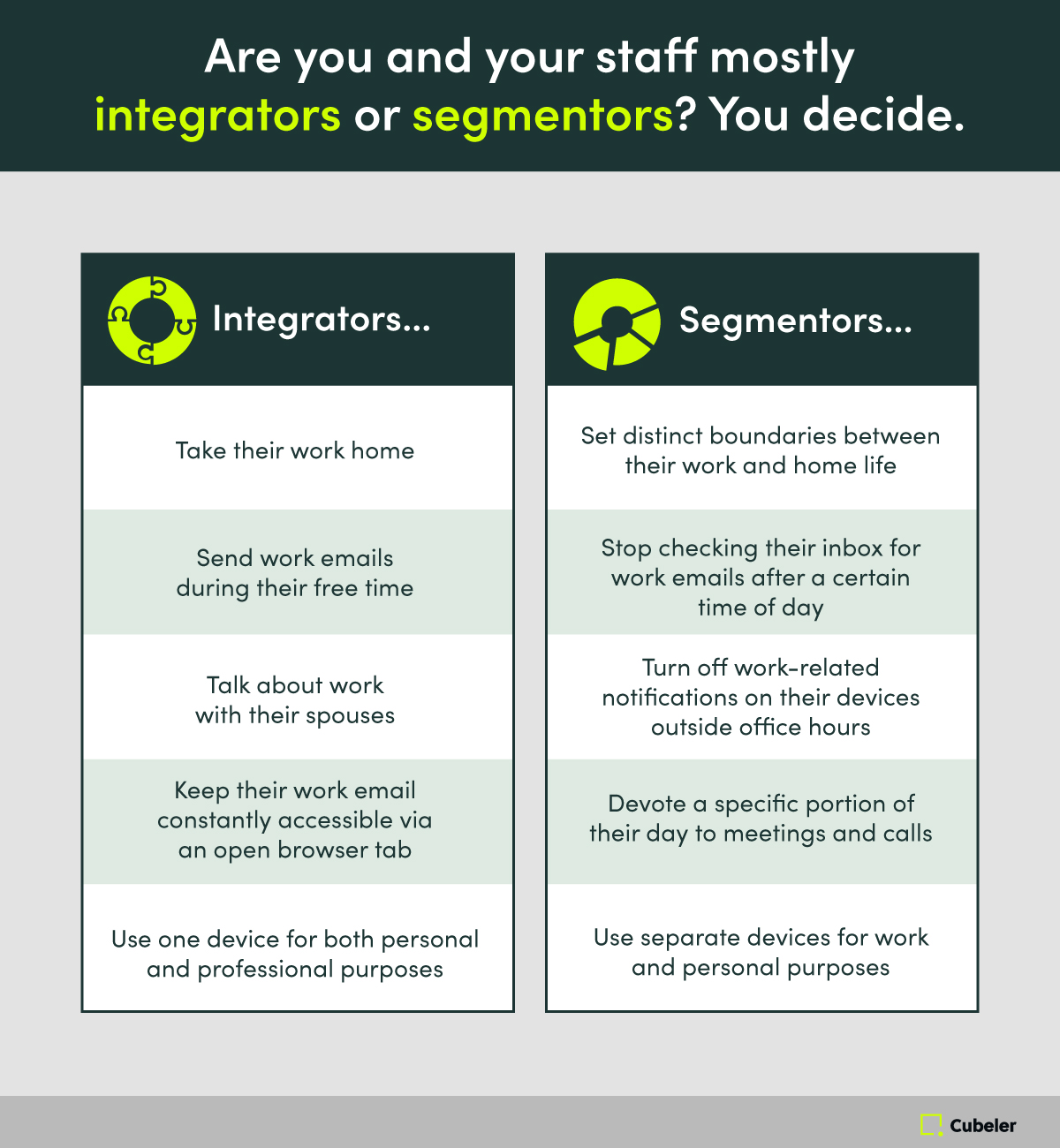5 Best Hacks to Combat Rising Costs and Shrinking Profits
Discover the steps you can take to weather tough times, from cutting costs without cutting quality to making money...
6 min read
By:
Cubeler en-ca
9-Feb-2023 9:00:00 AM

As the boss, it's crucial for you to maintain a healthy work-life balance and, at the same time, meet the work-life balance needs of your workers. Empowering yourself and your team to find the right balance between work and home life benefits everyone. Find out how right here.
As an SME owner or manager, it can be difficult to set aside personal time, especially when you operate a business from both your home and office.
The drive to constantly push your business forward can lead to a 24/7 work mentality, but this unrelenting pace can harm your well-being and affect your personal life.
It's crucial to achieve a healthy work-life balance, taking time to step away from work and, well, get a life.
It’s not just about dividing your time between work and leisure
In theory, achieving a work-life balance involves finding a healthy equilibrium between your professional and personal life.
In practice, it's not just about dividing your time equally between work and leisure—it requires a more sophisticated and personalized strategy. This sense of balance can look different for each individual and may change over time.
A more holistic approach would be to imagine work-life balance as that “happy place” between what you want to achieve and what fulfills you.
Striving for the ideal balance means you don’t have to choose one over the other. It's about advancing your career goals and exploring new and meaningful leisure pursuits.
Work-life balance is, in other words, all about leading a rewarding life outside of the office that improves your performance and reduces your stress at work.
Striking the perfect balance, as a result, means that your hours at the office should be counterbalanced by the time you spend with your loved ones, keeping fit, traveling and engaging in personal hobbies.
What work-life balance means for SME owners
For SME owners, running a business has many advantages and one major disadvantage: spending too much time at work. Even worse, this intense focus tends to make them neglect their life outside of the office, without them even realizing it.
Protecting your personal life from the demands of running a business requires conscious effort. As an SME owner, it's crucial to allocate enough time and energy to your family, friends and self-care.
Incorporating time management techniques into your everyday life can greatly enhance your work-life balance.
As the boss, you also need to recognize the work-life balance struggles of your workers. Empowering them to find a healthy balance in their own lives benefits everyone in the long run.
Why it’s hard for everybody to strike the perfect balance
Research indicates that work-life balance is becoming increasingly challenging. An Ernst and Young study found that one-third of employees worldwide population struggles to balance their work and personal lives.
This study found that generations X and Y (34% and 35% respectively) grapple more with work-life balance than boomers (30%), and women and parents (35%) face even greater difficulties than men (32%) and non-parents (31%).
The struggle for work-life balance is widespread due mostly to these reasons:
Inadequate compensation despite rising expenses
Longer work hours
Greater responsibilities both at home and at work
Parenthood
Job-related stress and strict workplace policies
Employers failing to accommodate the personal needs of employees
A work-life imbalance can have serious consequences
A study by workplace expert Graham Lowe revealed that a lack of balance between work and family life can lead to burnout, decreased productivity, frequent absences and, ultimately, higher employee turnover.
Beyond these serious consequences, an imbalanced work-life situation can also have these far-reaching and detrimental effects on you and your employees:
Depression
Stress
Weight gain
Loss of appetite
Increased fatigue
Sleep deprivation
Weakened immune systems
Unhealthy coping mechanisms
Heightened family conflict
Poor career advancement
When SME owners and employees spend too much time and energy on their work responsibilities, it can take a toll on their physical, mental and emotional well-being.
For employers and employees alike, a healthy work-life balance can bring numerous advantages, from less stress to a lower risk of burnout and a greater sense of well-being. This benefits both SME workers and owners.
SME owners committed to creating a work environment that fosters a healthy work-life balance for their employees tend to benefit from lower costs, reduced absenteeism and, most importantly, a more dedicated and productive staff.

There’s no one-size-fits-all work-life balance strategy
Striking the perfect balance between work and our personal lives is a highly personal pursuit—since our preferences and needs are unique.
In fact, studies have shown that it’s less about the job itself, and more about how our personality traits determine our capacity for balance.
In 2014, Diana Benito-Osorio, Laura Muñoz-Aguado and Cristina Villar conducted a comprehensive study of work-life balance policies spanning two decades, leading to 37 different work-life balance definitions.
The concept of work-life balance is multifaceted, with multiple definitions highlighting different aspects of the phenomenon.
Some definitions concentrate on the division of time between work and personal activities, such as our ability to effectively manage both personal and professional responsibilities.
Other definitions see the concept of work-life balance as a way to align our goals and priorities, balancing the demands of work, family, community involvement, personal growth, leisure and recreation.
Some definitions emphasize our mental state, considering work-life balance as the degree to which someone is fully engaged and content, both in their work and family life.
How personality determines your work-life boundaries
Sociologist Christena Nippert-Eng believes that there are two types of people when it comes to defining work-life boundaries: segmentors and integrators.
Segmentors possess a distinct ability to establish a clear divide between their professional and personal lives. For these individuals, the act of dividing work and life into separate mental compartments comes as naturally as riding a bicycle.
Integrators struggle to divide their time between work and their personal lives. They typically think about their home life at work and their work life at home. These individuals are also more likely to continue working and fixating on work-related matters, even outside of regular work hours.
Google work-life-balance research shows that segmentors “who rigidly separate their personal and work lives are significantly happier” than integrators “who tend to blur the lines between the two.”
Before you take the plunge into the murky depths of work-life balance strategizing, take a step back and determine where you and your employees fall on segmentor-integrator spectrum. This knowledge can help you identify the right work-life strategy for you and your team.

Striking the right balance for integrators and segmentors
Here are six more ways to achieve work-life balance, specifically designed to help keep both the integrators and segmentors on your team stay on track:
1. Use results-oriented performance metrics
Assessing anybody’s performance based solely on the number of hours they work is a flawed and outdated approach that’s still unfortunately practiced by many managers, often unconsciously. It’s crucial to establish clear objectives and performance metrics for each member of your team. By focusing on the attainment of goals and desired outcomes, it becomes irrelevant at what time of day the work is completed.
2. Establish core working hours
While it’s customary to set core working hours—for example, 10:00 am to 3:00 pm—it is also important to offer flexibility outside of these hours. This approach accommodates everybody’s needs, allowing segmentors to maintain a structured schedule and integrators to have the necessary leeway. Additionally, it offers your team the opportunity to avoid peak commuting hours.
3. Promote feedback and reflection
Conducting frequent retrospective meetings offers your entire team the opportunity to examine what's successful, identify challenges and develop solutions. This way, you can foster a culture of openness and be receptive to feedback from team members anytime or via scheduled one-on-one work meetings.
4. Don’t just work as a team
Occasionally, set aside time for everybody to unwind, reenergize and strengthen their work relationships. This harmonious blend of work and leisure is ideal for integrators. Additionally, scheduling these activities during work hours provides the people on your team who may avoid company social events, or "friends and family" days, with an opportunity to participate in all the fun.
5. Share each other’s work styles
While you may be aware that some of your employees are willing to respond to emails during the evening and others only check their inbox in the morning, it may be time to let their team members in on this valuable knowledge. Provide everyone with an opportunity to voice their preferences and jointly establish team norms and culture.
6. Give your tools a break
Whenever feasible, select tools that provide users with the ability to personalize their notification settings (for example, silencing all push notifications outside of work hours), so that both integrators and segmentors can establish their work and personal boundaries. Additionally, decide whether it's essential for team members to have work apps on their phones. Although integrators may enjoy the ease of using them any time of day, segmentors will appreciate the option to opt out from it all.
Quick takeaways
Maintaining a healthy work-life balance is hard enough. Meeting the work-life balance needs of your workers can sometimes feel even more daunting for you.
Here’s what you need to keep in mind when it comes to empowering yourself and your team to find the right balance between work and home:
The drive to constantly push your business forward can lead to a 24/7 work mentality, but this unrelenting pace can harm your well-being and affect your personal life.
In practice, maintaining a healthy work-life balance is more a holistic approach to finding that “happy place” between what you want to achieve and what fulfills you.
Protecting your personal life from the demands of running a business requires conscious effort. As an SME owner, it's crucial to allocate enough time and energy to your family, friends and self-care.
For you and your team, a lack of balance between work and family life can lead to burnout, decreased productivity, frequent absences and, ultimately, higher employee turnover.
For SME employers and employees, there are 20 proven ways to achieve a healthy work-life balance, from taking short breaks to setting up a designated quiet space at work.
Studies have shown that it’s less about the job itself, and more about how our personality traits determine our capacity for balance.
There are two types of people when it comes to defining work-life boundaries—segmentors and integrators—each with their own work styles.
Setting core working hours, sharing each other’s work styles and giving your tools a break are just some of the ways you can help make integrators and segmentors on your team happier and healthier.

Learn how to improve candidate targeting and outreach while reducing employee turnover with Cubeler’s quick-guide to...

Access LGBTQ+ resources for startups in Canada.